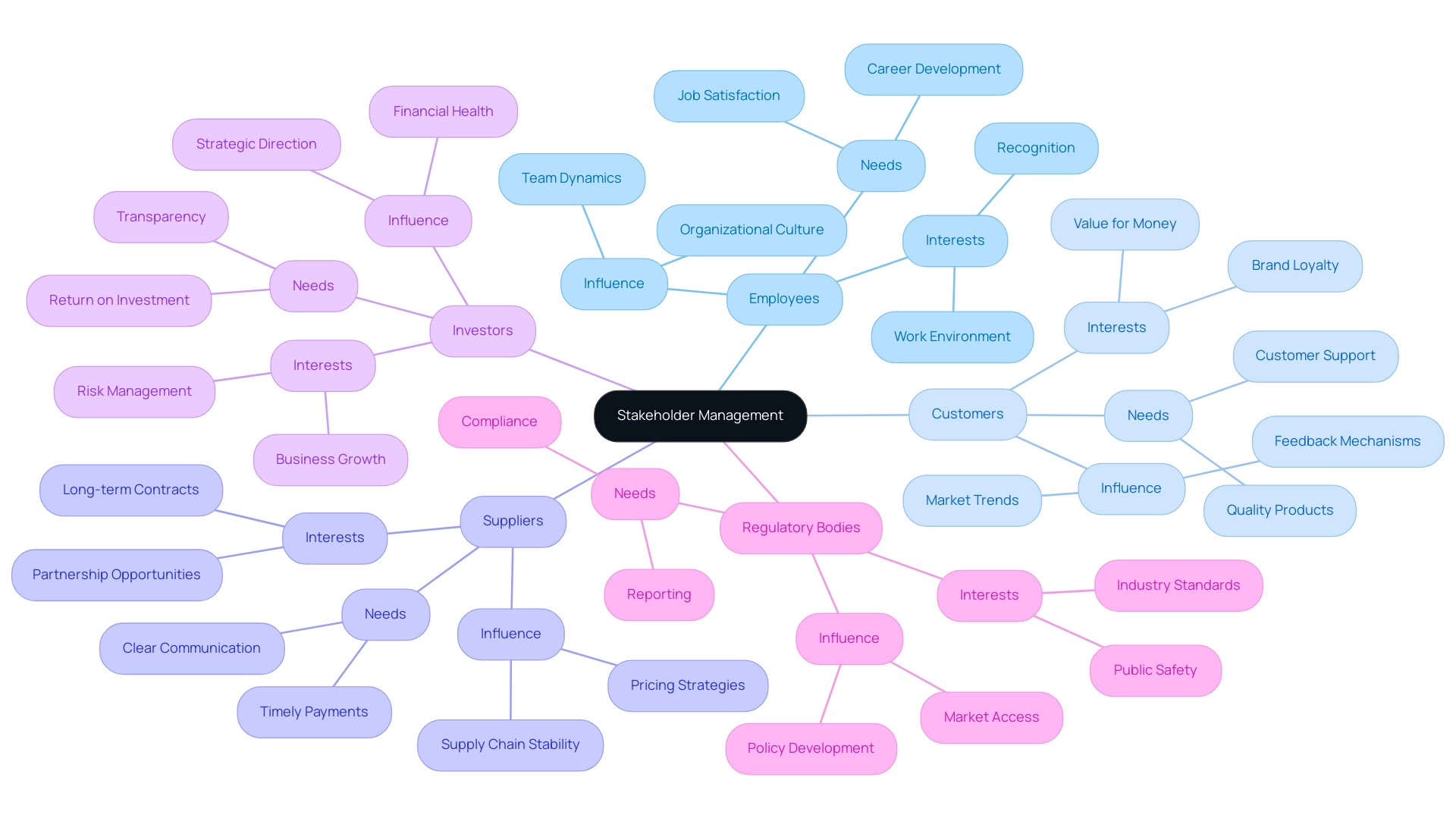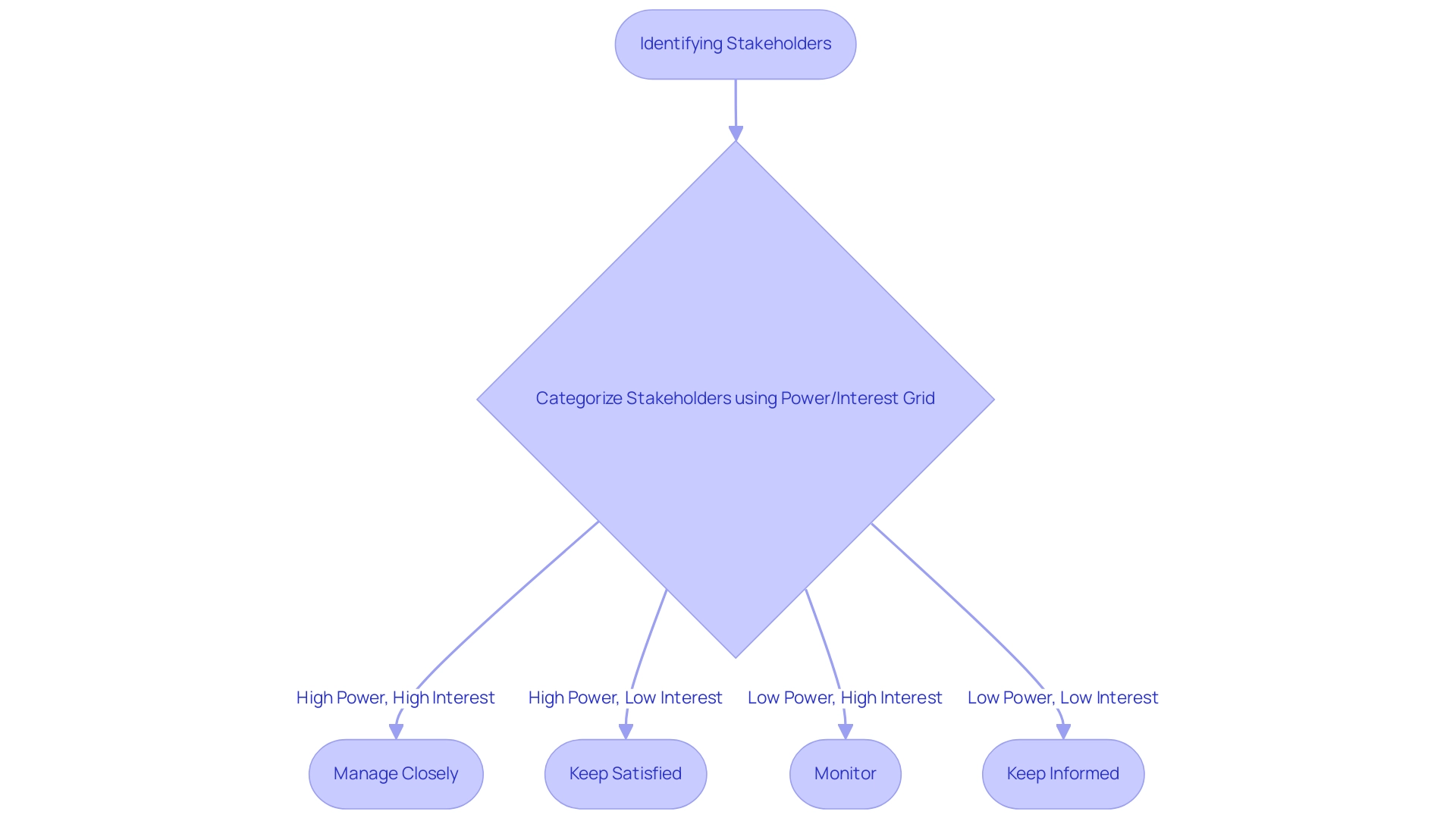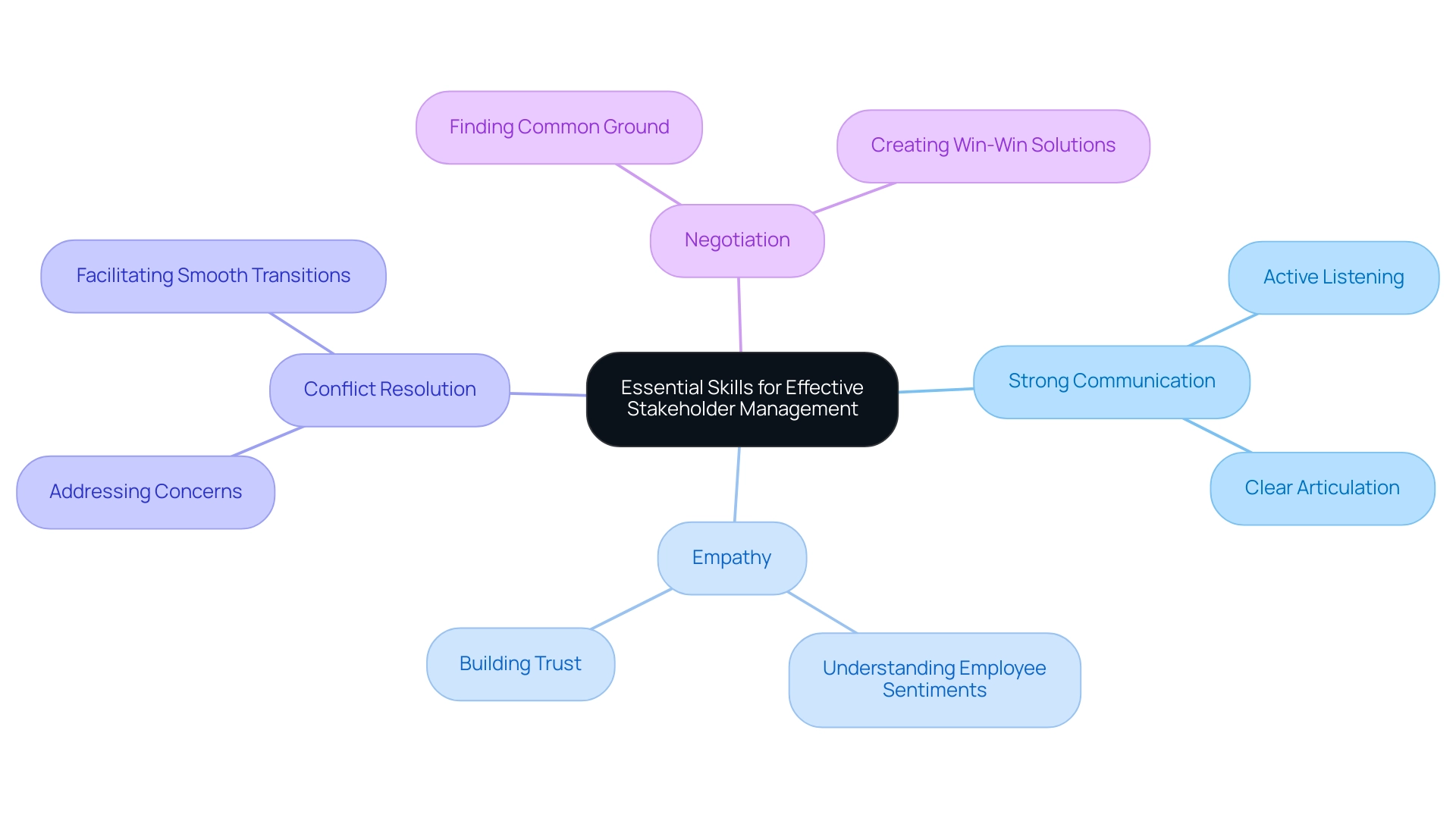Overview
Best practices for developing skills in stakeholder management include effective identification, prioritization, and engagement of stakeholders through tailored strategies and regular communication. The article emphasizes that successful stakeholder management not only enhances project outcomes and satisfaction rates but also fosters trust and collaboration, ultimately driving financial gains and project success.
Introduction
In an increasingly interconnected business environment, the ability to effectively manage stakeholder relationships is more critical than ever. Stakeholder management is not just a checkbox in project planning; it is a strategic imperative that can determine the success or failure of initiatives.
By understanding the diverse needs and influences of stakeholders—from employees and customers to investors and regulatory bodies—project leaders can craft engagement strategies that resonate and drive projects toward their objectives.
With evidence showing that projects excelling in stakeholder management are significantly more likely to succeed, the importance of cultivating these relationships cannot be overstated.
This article delves into the essential components of stakeholder management, offering practical insights and actionable steps for project managers to enhance engagement, leverage technology, and ultimately achieve better project outcomes.
Understanding Stakeholder Management: Definitions and Importance
Stakeholder oversight involves the strategic comprehension of the needs, interests, and influence of individuals or groups, emphasizing the skills in stakeholder management that significantly affect or are affected by an initiative. Initiatives that thrive in managing interests are 2.5 times more likely to reach their goals, highlighting its crucial part in success and risk reduction. Stakeholders can range from employees and customers to suppliers, investors, and regulatory bodies.
It is essential to involve interested parties early and sustain that involvement throughout the lifecycle, consistently identifying any new participants that may arise. By acknowledging the distinct importance of each participant group, managers can customize their interaction strategies successfully. As mentioned, by acknowledging the distinct requirements and impact of both internal and external participants, you can create engagement strategies that align with their priorities and propel your initiative toward success.
Tailored management of involved parties not only strengthens trust and commitment across all participants but also fosters a collaborative environment. For instance, the case study titled 'Waiting to be Shaped and Deployed' illustrates how assigning less influential colleagues to high-value initiatives can help them build connections and enhance their contributions to the organization. Moreover, initiatives that actively include input from interested parties not only align more closely with user requirements but also improve satisfaction rates.
Therefore, developing a thorough grasp of skills in stakeholder management is crucial for project leaders focused on implementing successful initiatives.

Key Steps in Effective Stakeholder Management: Identification and Prioritization
The cornerstone of effective skills stakeholder management lies in accurately identifying the involved parties. This initial phase can be facilitated through brainstorming sessions or utilizing advanced participant analysis tools. Once participants are recognized, it is essential to rank them according to their impact and interest related to the initiative.
A highly effective approach for this is the Power/Interest Grid, which segments interested parties into four distinct categories:
- Manage Closely
- Keep Satisfied
- Monitor
- Keep Informed
By directing efforts towards influential/high-interest parties, managers can effectively address their needs while simultaneously informing those in lower power positions to mitigate potential resistance. According to the Knowledge Base Chart, which assesses awareness and support levels among participants, understanding these dynamics is essential for successful engagement in skills stakeholder management.
Moreover, Patrick, a leader in significant infrastructure efforts, highlights the importance of skills stakeholder management, stating, 'Effective collaboration with involved parties is key to the success of any endeavor.' Furthermore, collaborative practices, such as sharing completed templates with team members, can yield additional insights and perspectives, as highlighted in the case study on sharing and reviewing these templates. This combined strategy not only strengthens relationships with involved parties but also develops skills in stakeholder management, driving project success.

Best Practices for Successful Stakeholder Engagement
To enhance participant involvement, strategies must be carefully customized for each group, considering their distinct concerns and expectations. Regular communication—through updates, meetings, and feedback sessions—is essential to keep interested parties informed and actively involved in the process. Transparency in decision-making not only fosters trust but also encourages collaborative efforts.
Methods like mapping parties can be extremely useful, as they assist in visualizing connections and enhancing interaction strategies. For example, creating a thorough participant involvement strategy that outlines communication techniques, frequencies, and designated duties can greatly improve alignment and participation throughout the initiative lifecycle. Organizations that execute effective participant strategies are 40% more likely to finish assignments on schedule and within budget, highlighting the financial benefits of strong involvement practices.
As emphasized by a HubSpot study, organizations with involved participants experience a 15% enhancement in outcomes, with 78% of initiatives succeeding compared to only 40% when involvement is minimal. Moreover, the case analysis named 'Measuring Engagement Effectiveness' demonstrates how involved parties lead to better alignment with company strategies, ultimately resulting in enhanced success of initiatives. By prioritizing these best practices, CFOs can drive substantial financial gains and project success through effective collaboration with involved parties.
As noted, "Good engagement with interested parties brings financial gains," emphasizing the critical need for effective strategies.
Essential Skills for Effective Stakeholder Management
Effective management of involved parties relies on a set of essential skills in stakeholder management, which includes:
- Strong communication
- Empathy
- Conflict resolution
- Negotiation
Project managers must articulate project goals with clarity while also being skilled listeners, addressing concerns with attentiveness. Emotional intelligence emerges as a pivotal competency, empowering leaders to navigate intricate interpersonal dynamics.
For example, during a restructuring process, a deep understanding of employee sentiments can significantly reduce resistance and facilitate a smoother transition. As Magda E. Ramos aptly states,
Your ability to communicate with your audience in a way that’s authentic to you and resonates with them is at least 50% of your job once you start climbing the ladder.
Establishing trust with interested parties can lead to a 10% better employee retention in tech, highlighting the importance of skills in stakeholder management.
To illustrate, a case study on leveraging management software highlights how Borealis centralizes data, enhances team collaboration, and streamlines communication, ultimately safeguarding the organization’s reputation and improving relationship management.
To further enhance these vital skills, workshops and targeted training programs focused on participant engagement are invaluable resources for managers. Furthermore, it is essential to recognize that effective communication with interested parties is a key aspect of skills in stakeholder management that can be continuously developed throughout one's career.

Leveraging Technology for Enhanced Stakeholder Management
Utilizing technology is essential for improving participant management, especially via the use of management software, CRM systems, and collaboration platforms. Tools like Asana and Trello not only assist in monitoring interactions and project updates but also ensure that all parties stay aligned and informed. Our team's approach supports a shortened decision-making cycle throughout the turnaround process, allowing your team to take decisive action to preserve your business.
With 39% of social media users expressing a desire for quick responses, timely communication becomes essential in maintaining strong relationships. Moreover, integrating real-time analytics into these platforms enables organizations to continuously monitor business performance and gain valuable insights into participant behavior and preferences, leading to more personalized engagement strategies. The client dashboard we provide offers real-time business analytics, allowing for ongoing assessment and adaptation of strategies.
The case study on the hybrid approach demonstrates that combining AI-driven data analysis with traditional relationship-building methods leads to strong management of involved parties. This balance of efficiency and human insight enhances communication quality, task completion rates, and overall participant satisfaction, ultimately contributing to improved project outcomes. As the saying goes, 'Good collaboration with interested parties brings financial gains,' highlighting the economic advantages of effective teamwork.
By utilizing these technologies and consistently tracking your business health through real-time analytics, organizations can promote greater transparency and accountability, which are essential for achieving a high return on investment. The capability to modify and adapt strategies according to real-time information guarantees that organizations can stay flexible in their interactions with interested parties. Metrics related to communication quality, task completion, stakeholder satisfaction, and goal alignment are critical for assessing engagement ROI, reinforcing the necessity of these tools in today's skills stakeholder management landscape.
Conclusion
Effectively managing stakeholder relationships is not merely a component of project management; it is a pivotal strategy that can significantly influence project success. Understanding the diverse needs and interests of stakeholders—from employees to regulatory bodies—enables project leaders to tailor their engagement strategies, fostering trust and collaboration. By prioritizing stakeholder management, organizations can enhance satisfaction and align their projects with stakeholder expectations.
Key steps such as:
- Identifying and prioritizing stakeholders
- Employing tailored engagement practices
- Leveraging technology
are essential for building strong stakeholder relationships. Utilizing tools like the Power/Interest Grid and stakeholder mapping can streamline efforts and ensure that communication remains consistent and transparent. Moreover, the integration of project management software and real-time analytics allows for agile adaptations to engagement strategies, further driving project outcomes.
Ultimately, the commitment to effective stakeholder management not only leads to higher project success rates but also translates into financial benefits for organizations. As the evidence suggests, projects with robust stakeholder engagement are significantly more likely to meet their objectives, reinforcing the importance of cultivating these relationships. It is imperative for project managers to invest in developing essential skills and utilizing technology to foster greater stakeholder engagement, ensuring that projects are delivered on time and within budget. Prioritizing these strategies will yield substantial returns, making stakeholder management a cornerstone of successful project execution.
Frequently Asked Questions
What is stakeholder oversight?
Stakeholder oversight involves understanding the needs, interests, and influence of individuals or groups, focusing on stakeholder management skills that impact initiatives. Effective management of interests increases the likelihood of achieving goals by 2.5 times.
Who are considered stakeholders?
Stakeholders can include employees, customers, suppliers, investors, and regulatory bodies, among others.
Why is early involvement of stakeholders important?
Involving stakeholders early and maintaining their involvement throughout the initiative lifecycle helps to identify new participants and tailor interaction strategies, enhancing the chances of success.
How can managers effectively engage different stakeholder groups?
Managers can customize engagement strategies by recognizing the distinct importance of each stakeholder group, aligning their priorities with the initiative's goals.
What are the benefits of tailored management of stakeholders?
Tailored management strengthens trust and commitment among participants, fosters collaboration, and leads to initiatives that better align with user requirements, improving satisfaction rates.
How can stakeholders be identified and categorized?
Stakeholders can be identified through brainstorming sessions or participant analysis tools and can be categorized using the Power/Interest Grid, which segments them into four categories: Manage Closely, Keep Satisfied, Monitor, and Keep Informed.
What is the significance of the Power/Interest Grid?
The Power/Interest Grid helps managers prioritize their efforts towards influential and high-interest stakeholders while keeping those with lower power informed to reduce resistance.
How can collaborative practices enhance stakeholder management?
Collaborative practices, such as sharing completed templates with team members, can provide additional insights and strengthen relationships with stakeholders, thereby improving skills in stakeholder management and driving project success.




